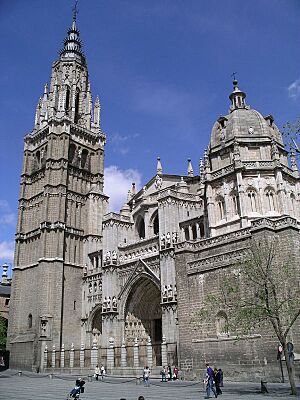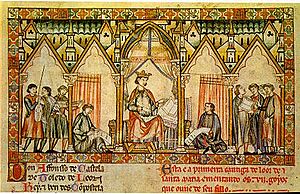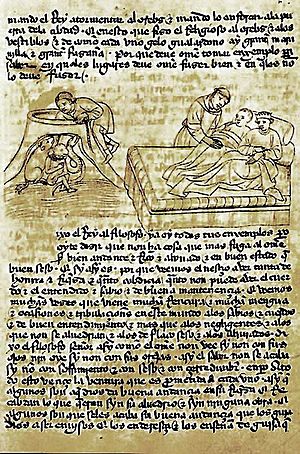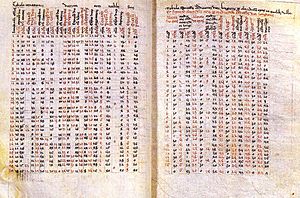Toledo School of Translators facts for kids

The Toledo School of Translators (Spanish: Escuela de Traductores de Toledo) was a group of smart people who worked together in the city of Toledo, Spain. They lived in the 12th and 13th centuries. Their main job was to translate important books from Classical Arabic into Medieval Latin. These books were about philosophy and science, often written by thinkers from Jewish and Islamic cultures.
The School had two main periods. The first was in the 12th century, led by Archbishop Raymond of Toledo. He focused on translating philosophical and religious books from Arabic into Latin. Later, in the 13th century, under King Alfonso X of Castile, things changed. Translators started putting books into Old Spanish instead of Latin. This helped create the first standard version of the Spanish language.
Contents
History of the Translators
Why Toledo Was Special
Toledo was always a place where many cultures and languages mixed. Even when Muslims ruled the city, it was a hub for learning and translation. Many old books by famous thinkers like Aristotle, Hippocrates, and Ptolemy had been translated into Arabic during the Islamic Golden Age. These books, along with new works by Arabic-speaking scientists like Ibn Sina, were well-known in Al-Andalus (Muslim Spain).
This meant that people in Muslim lands knew a lot about ancient subjects that were hard to find in Christian parts of Europe. Some Arabic books were also translated into Latin, Hebrew, and Ladino.
Toledo's rich mix of cultures made it a popular place for European scholars to visit and study. People spoke Arabic, Hebrew, Latin, and local Spanish. This led to new ways of speaking and writing. Many Arabic-speaking Christians, called Mozarabs, were also available to help with translations. But organized translation efforts really began after Christian forces took Toledo back in 1085. The new rulers found huge libraries full of advanced scientific and philosophical books, mostly in Arabic.
Another reason Toledo was important was that some Christian leaders in other parts of Europe thought many scientific ideas were wrong. For example, at the University of Paris, they tried to stop the teaching of Aristotle's physics and the works of Averroes. But in Toledo, these ideas were studied and translated.
Early Days of Translation
Raymond of Toledo, who was the Archbishop of Toledo from 1126 to 1151, started the first big translation projects. He gathered a team at the Cathedral of Toledo's library. This team included Mozarabic Christians, Jewish scholars, teachers from Madrasahs, and monks. They translated many important texts, mostly from Arabic, Jewish, and Greek into Latin. The Spanish language was not yet fully developed for this kind of work.
These scholars made many key books available. They focused on works by Arabic and Hebrew philosophers, especially those who helped understand Aristotle. Because of their efforts, the cathedral library became a very important translation center.

Gerard of Cremona was one of the most active translators in Toledo. He translated over 87 books on Arabic science. He came to Toledo in 1167 looking for Ptolemy's Almagest, a famous astronomy book. Since he didn't know Arabic, he worked with Jewish and Mozarab scholars who taught him and helped him translate.
His translations included works by:
- Ptolemy (like the Almagest)
- Aristotle (books on physics, heavens, and ethics)
- al-Khwarizmi (on algebra)
- Archimedes (on circles)
- Euclid (on geometry)
- Many other important scientists and doctors from the Islamic world.
Gerard also helped create the "Toledan Tables." These were the most accurate astronomy tables in Europe at the time, based on the work of Arabic astronomers. He also translated many medical books by famous doctors like Avicenna and Rhazes.
John of Seville was another important translator. He worked with Dominicus Gundissalinus in the early days. John translated from Arabic into Castilian. He translated Secretum Secretorum, a book about many topics like leadership, ethics, and medicine, which was very popular in Europe. He also translated many books on astrology and philosophy.
Rudolf of Bruges, an astronomer, translated a major work on the astrolabe (a tool for astronomy) from Arabic into Latin.
Dominicus Gundissalinus is thought to be the first director of the Toledo School of Translators, starting around 1180. At first, he translated from Greek into Latin or Castilian, relying on John of Seville for Arabic texts. Later, he learned Arabic himself. He focused on philosophy, translating works by Greek and Muslim thinkers like ibn Gabirol, Avicenna, and al-Ghazâlî.
Michael Scot, a scholar from Scotland, also worked in Toledo. He translated many of Aristotle's scientific works and important writings by Averroes.
Herman the German was a bishop who worked in Toledo. He translated Aristotle's Nicomachean Ethics and works by Averroes and Alfarabi.
Changes Over Time
After Archbishop Raymond died, translation work slowed down but didn't stop. Some translators, like Herman the German, worked in both periods. During this time, the first direct translations from Arabic into the local Spanish language (Castilian) began.
Mark of Toledo, a doctor, translated the Qur'an and several medical books.
Alfred of Sareshel, an English translator, worked on books about plants and alchemy.
John of Toledo, a doctor, studied medicine in Toledo before becoming a cardinal and the Pope's personal physician. He translated medical books.
King Alfonso X and the School
Under King Alfonso X of Castile (known as "the Wise"), Toledo became even more important for translation and writing new scholarly works. The King didn't officially create a "school," but the group of scholars worked together, sharing knowledge and teaching new people. The King paid for most of their work and even brought skilled translators from other parts of Spain and Europe to Toledo.
King Alfonso made a big change: he decided that books should be translated into a clear version of Castilian Spanish, not Latin. This was very important for the Spanish language. He wanted the texts to be "easy to understand" so that more people could read them. Scholars from places like Italy, Germany, and England came to Toledo, learned from the Arabic, Greek, and Hebrew texts, and then took that knowledge back home. The King also ordered the translation of famous "oriental" stories, like Kalila wa-Dimna, which were originally in Sanskrit but translated into Arabic first.
The way translations were done also improved under Alfonso X. Before, someone who knew the original language would speak the text aloud, and another scholar would write it down in Latin. Now, a translator who knew several languages would translate directly into Castilian for a scribe to write. The King himself, who loved science, history, and law, would review the work. He managed the translators and encouraged discussions.
Under Alfonso, Sephardic Jewish scientists and translators became very important. The King valued their intelligence and their knowledge of Arabic and Castilian. He even kept some Jewish scholars as his personal doctors. The King was so impressed that he asked for translations of the Talmud (Jewish law) and the Kabbalah, hoping to show they supported Christian ideas.
The first known translation from this period was the Lapidario, a book about the healing powers of rocks and gems. It was translated by Yehuda ben Moshe Cohen from Arabic into Castilian.
Yehuda ben Moshe was one of the most famous Jewish translators and the King's physician. He translated many important books on magic, astrology, and astronomy, including works by Ptolemy and Al-Zarqali.
Yehuda ben Moshe also helped create the famous Alfonsine tables. These tables, put together by Isaac ibn Sid, helped people figure out where the Sun, Moon, and planets were in the sky. They were based on observations by astronomers the King brought to Toledo. These tables became very popular in Europe and were used for over 300 years. Even Copernicus owned a copy!
Isaac ibn Sid was another skilled Jewish translator. He was an expert in astronomy, astrology, and math. He translated books on tools like the astrolabe, making them easy for anyone to understand. He also worked on books about making clocks.
Rabbi Zag Sujurmenza translated works on different types of astrolabes and constellations.
Abraham of Toledo, a doctor for the King, translated books on the universe and the astrolabe. Other Jewish translators included Samuel ha-Levi and Abulafia de Toledo.
Among the Christian translators was Alvaro de Oviedo, who translated a book on astrology. He did a Latin translation while Yehuda ben Moshe gave him an oral Spanish translation of the Arabic text. This was a rare case of two translations happening at once.
Maestre Joan de Cremona, the King's notary, also translated parts of astronomy books.
What Happened Next
After King Alfonso died, his successor, Sancho IV of Castile, broke up most of the translation team. Many translators left Toledo and found new work elsewhere.
Why It Was Important
The translations made in Toledo were incredibly important for Europe. Books on astronomy, astrology, algebra, and medicine, which had been unavailable for centuries, now spread across the continent. Scholars from all over Europe came to Toledo to learn directly from these texts. Even though some European universities banned works by Aristotle and Arab philosophers, the Toledo translations were accepted because they focused on science and the natural world.
Many famous thinkers used these translations:
- Albertus Magnus based much of his work on science and philosophy on the Toledo translations.
- His student, Thomas Aquinas, also used these translated works in his philosophical and religious writings.
- Roger Bacon used Arabic translations to make big discoveries in optics, astronomy, and chemistry.
- Many doctors in Europe learned a lot from the translated medical books, which showed the advanced state of medicine in the Islamic world.
Nicolaus Copernicus, who first said that the sun, not the Earth, was the center of the universe, studied Ptolemy's Almagest translation. He also used the Alfonsine tables for his calculations. These tables were a huge step forward for astronomy in Europe.
Another great result of this translation work was the improvement of the Castilian Spanish language. It gained many new scientific words and became easier to understand for everyone. The work of these scholars, guided by King Alfonso X, laid the foundation for the modern Spanish language spoken today.
See also
 In Spanish: Escuela de Traductores de Toledo para niños
In Spanish: Escuela de Traductores de Toledo para niños
- Translations during the Spanish Golden Age
- Latin translations of the 12th century
- Islamic contributions to Medieval Europe





